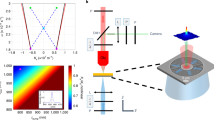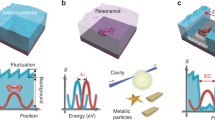Abstract
Control of light–matter interactions at the nanoscale has advanced fields such as quantum optics1, photovoltaics2 and telecommunications3. These advances are driven by an improved understanding of the nanoscale behaviour of light, enabled by direct observations of the local electric fields near photonic nanostructures4,5,6. With the advent of metamaterials that respond to the magnetic component of light7,8, schemes have been developed to measure the nanoscale magnetic field9,10,11,12. However, these structures interact not only with the magnetic field, but also with the electric field of light. Here, we demonstrate the essential simultaneous detection of both electric and magnetic fields with subwavelength resolution. By explaining our measurements through reciprocal considerations, we create a route towards designing probes sensitive to specific desired combinations of electric and magnetic field components. Simultaneous access to nanoscale electric and magnetic fields will pave the way for new designs of optical nanostructures and metamaterials.
This is a preview of subscription content, access via your institution
Access options
Subscribe to this journal
Receive 12 print issues and online access
$209.00 per year
only $17.42 per issue
Buy this article
- Purchase on Springer Link
- Instant access to full article PDF
Prices may be subject to local taxes which are calculated during checkout



Similar content being viewed by others
Change history
03 February 2014
The reference section in the print version of this Letter contained the following errors: For ref. 3, the volume number should have been 4 rather than 3. For ref. 17, "15, 1289-1295" should have been http://dx.doi.org/10.1126/science.1232009. For ref. 30, the volume number should have been 326 rather than 23. The online HTML and PDF versions of the Letter do not contain these errors.
References
O’Brien, J. L., Furusawa, A. & Vučković, J. Photonic quantum technologies. Nature Photon. 3, 687–695 (2009).
Atwater, H. A. & Polman, A. Plasmonics for improved photovoltaic devices. Nature Mater. 9, 205–213 (2010).
Liu, X., Osgood, R. M., Vlasov, Y. A. & Green, W. M. J. Mid-infrared optical parametric amplifier using silicon nanophotonic waveguides. Nature Photon. 4, 557–560 (2010).
López-Tejeira, F. et al. Efficient unidirectional nanoslit couplers for surface plasmons. Nature Phys. 3, 324–328 (2007).
Dorfmüller, J. et al. Near-field dynamics of optical Yagi-Uda nanoantennas. Nano Lett. 11, 2819–2824 (2011).
Balistreri, M. L. M., Korterik, J. P., Kuipers, L. & van Hulst, N. F. Local observations of phase singularities in optical fields in waveguide structures. Phys. Rev. Lett. 85, 294–297 (2000).
Shalaev, V. M. Optical negative-index metamaterials. Nature Photon. 1, 41–48 (2007).
Smith, D. R., Padilla, W. J., Vier, D. C., Nemat-Nasser, S. C. & Schultz, S. Composite medium with simultaneously negative permeability and permittivity. Phys. Rev. Lett. 84, 4184–4187 (2000).
Kihm, H. W. et al. Bethe-hole polarization analyser for the magnetic vector of light. Nature Commun. 2, 451 (2011).
Taminiau, T. H., Karaveli, S., van Hulst, N. F. & Zia, R. Quantifying the magnetic nature of light emission. Nature Commun. 3, 979 (2012).
Olmon, R. L. et al. Determination of electric-field, magnetic-field, and electric-current distributions of infrared optical antennas: a near-field optical vector network analyzer. Phys. Rev. Lett. 105, 167403 (2010).
Devaux, E. et al. Local detection of the optical magnetic field in the near zone of dielectric samples. Phys. Rev. B. 62, 10504–10514 (2000).
Betzig, E. & Chichester, R. J. Single molecules observed by near-field scanning optical microscopy. Science 262, 1422–1425 (1993).
Bozhevolnyi, S. I., Volkov, V. S., Devaux, E., Laluet, J. Y. & Ebbesen, T. W. Channel plasmon subwavelength waveguide components including interferometers and ring resonators. Nature 440, 508–511 (2006).
Schnell, M. et al. Controlling the near-field oscillations of loaded plasmonic nanoantennas. Nature Photon. 3, 287–291 (2009).
Burresi, M. et al. Observation of polarization singularities at the nanoscale. Phys. Rev. Lett. 102, 033902 (2009).
Kildishev, A. V., Boltasseva, A. & Shalaev, V. M. Planar photonics with metasurfaces. Science http://dx.doi.org/10.1126/science.1232009 (2013).
Ergin, T., Stenger, N., Brenner, P., Pendry, J. B. & Wegener, M. Three-dimensional invisibility cloak at optical wavelengths. Science 328, 337–339 (2010).
Ren, M., Plum, E., Xu, J. & Zheludev, N. I. Giant nonlinear optical activity in a plasmonic metamaterial. Nature Commun. 3, 833 (2012).
Soukoulis, M. & Wegener, M. Past achievements and future challenges in the development of three-dimensional photonic metamaterials. Nature Photon. 5, 523–530 (2011).
Van Labeke, D. & Barchiesi, D. Probes for scanning tunneling optical microscopy: a theoretical comparison. J. Opt. Soc. Am. A 10, 2193–2201 (1993).
Porto, J. A., Carminati, R. & Greffet, J. J. Theory of electromagnetic field imaging and spectroscopy in scanning near-field optical microscopy. J. Appl. Phys. 88, 4845–4850 (2000).
Esslinger, M. & Vogelgesang, R. Reciprocity theory of apertureless scanning near-field optical microscopy with point-dipole probes. ACS Nano 6, 8173–8182 (2012).
Joannopoulos, J. D., Johnson, S. G., Winn, J. N. & Meade, R. D. in Photonic Crystals: Molding the Flow of Light Ch. 7 (Princeton Univ. Press, 2011).
Johnson, S. G. & Joannopoulos, J. D. Block-iterative frequency-domain methods for Maxwell’s equations in a planewave basis. Opt. Express 8, 173–190 (2001).
Engelen, R. J. P., Mori, D., Baba, T. & Kuipers, L. Subwavelength structure of the evanescent field of an optical Bloch wave. Phys. Rev. Lett. 102, 023902 (2009).
Kihm, H. W. et al. Optical magnetic field mapping using a subwavelength aperture. Opt. Express 21, 5625–5633 (2013).
Rotenberg, N. et al. Plasmon scattering from single subwavelength holes. Phys. Rev. Lett. 108, 127402 (2012).
Yi., J. M. et al. Diffraction regimes of single holes. Phys. Rev. Lett. 109, 023901 (2012).
Burresi, M. et al. Probing the magnetic field of light at optical frequencies. Science 326, 550–553 (2009).
Acknowledgements
The authors thank M. P. van Exter and J. J. Greffet for useful discussions and H. Schoenmaker for fabricating near-field probes. This work is supported by NanoNextNL of the Government of the Netherlands and 130 partners, as well as part of the research programme of the Stichting voor Fundamenteel Onderzoek der Materie (FOM), which is financially supported by the Nederlandse Organisatie voor Wetenschappelijk Onderzoek (NWO). Part of this work was funded by the project ‘SPANGL4Q’, which has financial support from the Future and Emerging Technologies (FET) programme within the Seventh Framework Programme for Research of the European Commission (FET—Open grant no. FP7-284743).
Author information
Authors and Affiliations
Contributions
B.F. and L.K. designed the experiment. B.F. conducted the experiment. N.R. and B.F. analysed the data. D.M.B. fabricated the sample. D.M.B. and B.F. performed simulations. The manuscript was prepared with contributions from all authors.
Corresponding authors
Ethics declarations
Competing interests
The authors declare no competing financial interests.
Supplementary information
Supplementary information
Supplementary information (PDF 632 kb)
Rights and permissions
About this article
Cite this article
le Feber, B., Rotenberg, N., Beggs, D. et al. Simultaneous measurement of nanoscale electric and magnetic optical fields. Nature Photon 8, 43–46 (2014). https://doi.org/10.1038/nphoton.2013.323
Received:
Accepted:
Published:
Issue Date:
DOI: https://doi.org/10.1038/nphoton.2013.323
This article is cited by
-
Attosecond electron microscopy of sub-cycle optical dynamics
Nature (2023)
-
Recent advances in tip-enhanced Raman spectroscopy probe designs
Nano Research (2023)
-
Measuring the magnetic topological spin structure of light using an anapole probe
Light: Science & Applications (2022)
-
Radiationless anapole states in on-chip photonics
Light: Science & Applications (2021)
-
Near-field transmission matrix microscopy for mapping high-order eigenmodes of subwavelength nanostructures
Nature Communications (2020)



